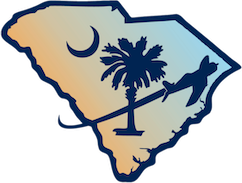
AviCom 2025
AviCom is an aviation competition for high school students, where teenagers compete for awards that propel their aviation journey. The competition is designed to recognize those who are most likely to be successful, safe, and proficient aviation professionals.
The competition includes an individual airman knowledge test, an individual aircraft recognition test, and a scenario-based simulated flight conducted as a team. All competitors must be part of a team. Team members must participate in AviCom Qualifying events. Contact the Event Director to schedule an AviCom Qualifying event for your school.
AviCom 2025 is organized by Greenville Technical Charter High School. Participating schools are considered part of the South Carolina Aviation Education Alliance.
- Where
- TBD
- When
- TBD
- Mission Briefing
- TBD

Mission Objectives
The mission is for students to demonstrate their aviation knowledge and skills through competition aligned with the following academic standards:
- Asking Question and Defining Problems (HS-ETS1-1)
- Analyze the performance characteristics of a given aircraft to operate at peak efficiency for specific atmospheric conditions.
- Constructing Explanations and Designing Solutions (HS-ETS1-6)
- Plan a cross-country flight, optimizing fuel efficiency based on the trade-offs between flying routes and altitudes, while staying in compliance with regulations.
- Developing and Using Models (HS-ETS1-4)
- Use computer simulation to model a planned cross-country flight, flying according to standard operating procedures and interacting with changing conditions.
- Determine Meaning from Technical Documents (RST.11-12.4)
- Obtain, interpret, and apply information from official sources, including aviation maps, aircraft performance charts, airport diagrams, and weather reports.
Mission Competition Details
Students will compete in teams and individually. Teams will compete in a simulated flight. Individually, students will be tested on airman knowledge and aircraft identification.
Airman Knowledge
Multiple-choice, time-limited test aligned with the following Airman Certification Standards:
- PA.I.C - Weather Information
- PA.I.E - National Airspace
- PA.I.F - Performance and Limitations
- PA.I.G - Operation of Systems
- PA.I.H - Human Factors
- PA.III.B - Traffic Patterns
- PA.VI.A - Pilotage and Dead Reckoning
Aircraft Identification
Students will be given a multiple-choice test to identify twenty (20) aircraft by manufacturer, model, and common name, including military, commercial, and general aviation aircraft.
Simulated Flight Mission Completion Criteria
Competitors are expected to be able to plan a VFR flight and use a flight simulator to execute their plan. The exact details of the mission, including aircraft type, departure airport, arrival airport, and weather outlook, will be revealed during the briefing the evening before the event. After the mission briefing and before the simulated flight, students will develop their flight plans only with the other team members. Teachers, coaches, instructors, and parents should not help students with flight plans. Competitors will execute their planned flight on the day of the competition using the simulators provided. Teams will be evaluated on the time and fuel required to complete the flight, minus any demerits for violating mission completion criteria. There will be a time limit.
Mission completion criteria will be explained during the briefing. To prepare for the competition, students should use a simulator to practice:
- Taxi to the correct runway based on wind conditions.
- Hold short of the runway until cleared for takeoff.
- On departure, climb to an appropriate VFR cruising altitude and hold altitude (+/-200’) until no more than 10 miles from the arrival airport unless an altitude change is required to maintain VFR, avoid airspace restrictions, or clear terrain.
- Navigate by pilotage and dead reckoning.
- Clear all obstacles by 1000’ and clear wilderness areas by 2000’.
- Stay out of any controlled airspace without authorization (teams are authorized for their departure airport airspace, arrival airport, and all Class E airspace outside of prohibited and restricted airspace).
- Abide by cloud clearance and speed limits.
- Avoid excessive bank and pitch angles.
- Land on the correct runway based on wind conditions.
- Stay on paved surfaces.
- Taxi to the ramp.
- Park in a parking space and set the parking brake.
Rules
This is not a complete list of rules, but it will get you started.
AviCom Qualifying Events
An AviCom Qualifying Event is a free online test administered to team members at each participating organization. The typical organization is a high school with aviation courses or an after-school aviation program. Other organizations (from now on referred to as "schools") may also participate, including but not limited to the Civil Air Patrol, Scouts, and home school collectives. Teams will consist of members enrolled as South Carolina 9th, 10th, 11th, or 12th grade students. Team members may be student pilots but must not have yet completed their primary pilot certification. Every team must have an adult teacher, coach, or leader (from now on referred to as "teacher") who is the point of contact with the AviCom Event Director. Teachers will coordinate with the Event Director to schedule a date/time for the online test.
Regionals
The Regional test will be a multiple-choice Airman Knowledge Test aligned with the Mission Objectives. The test will be administered through GradeCam or a similar online assessment tool. The test will be timed. All team members will take the test simultaneously, and the teacher will be responsible for assuring that the individual test scores are those of the students. The school's score will be determined from the team's average.
Selection for the State-level Competition
Ten teams will compete in person at the state competition. The highest-scoring school from each region will advance to the state-wide event. Regions are defined by the state's seven (7) congressional districts. Returning state champions and this year’s host school will automatically advance to the state-level competition. One "At Large" team will be selected from the top-scoring school that has not already been chosen for the state competition. If one or more Districts do not field a team, additional At Large teams will be added.
Prizes and Trophies
AviCom awards teams and individuals for top performance in airman knowledge, aircraft recognition, and simulated flight.
- Grand Prize
-
TBD
- Team Prize for the Simulated Flight Competition
-
TBD
- Individual Prizes for the Airman Knowledge Competition
-
TBD
- Individual Prizes for the Aircraft Identification Competition
-
TBD

